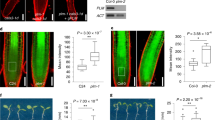Abstract
The systemin precursor, prosystemin, has been previously shown to be sequestered in vascular bundles of tomato (Lycopersicon esculentum Mill.) plants, but its subcellular compartmentalization and association with a specific cell type has not been established. We present in situ hybridization and immunocytochemical evidence at the light, confocal, and transmission electron microscopy levels that wound-induced and methyl jasmonate-induced prosystemin mRNA and protein are exclusively found in vascular phloem parenchyma cells of minor veins and midribs of leaves, and in the bicollateral phloem bundles of petioles and stems of tomato. Prosystemin protein was also found constitutively in parenchyma cells of various floral organs, including sepals, petals and anthers. At the subcellular level, prosystemin was found compartmentalized in the cytosol and the nucleus of vascular parenchyma cells. The cumulative data indicate that vascular phloem parenchyma cells are the sites for the synthesis and processing of prosystemin as a first line of defense signaling in response to herbivore and pathogen attacks.






Similar content being viewed by others
Abbreviations
- IgG:
-
immunoglobulin
- TEM:
-
transmission electron microscope
References
Constabel CP, Yip L, Ryan CA (1998) Prosystemin from potato, black nightshade, and bell pepper: primary structure and biological activity of predicted systemin polypeptides. Plant Mol Biol 36:55–62
Délano PJ, Dombrowski JE, Ryan CA (1999) The expression of tomato prosystemin in Escherichia coli: a structural challenge. Protein Expr Purif 17:74–82
Dombrowski JE, Pearce G, Ryan CA (1999) Proteinase Inhibitor-inducing activity of the prohormone prosystemin resides exclusively in the C-terminal systemin domain. Proc Natl Acad Sci USA 96:12947–12952
Farmer EE, Johnson RJ, Ryan CA (1992) Regulation of expression of proteinase inhibitor genes by methyl jasmonate and jasmonic acid. Plant Physiol. 98:995–1002
Hause B, Stenzel I, Miersch O, Maucher H, Kramel R, Ziegler J, Wasternack C (2000) Tissue-specific oxylipin signature of tomato flowers: allene oxide cyclase is highly expressed in distinct flower organs and vascular bundles. Plant J 24, 113–126
Haywood V, Kragler F, Lucas WJ (2002) Plasmodesmata: pathways for protein and ribonucleoprotein signaling. Plant Cell [Suppl] 14:303–325
Jacinto T, McGurl B, Franceschi V, Delano-Freier J, Ryan CA (1997) Tomato prosystemin promoter confers wound-inducible, vascular bundle-specific expression of the β-glucuronidase gene in transgenic tomato plants. Planta 203:406–412
Lee GI, Howe GA (2003) The tomato mutant spr1 is defective in systemin perception and the production of a systemic wound signal for defense gene expression. Plant J 33:567–576
Li L, Li C, Lee GI, Howe GA (2002) Distinct roles for jasmonate synthesis and action in the systemic wound response of tomato. Proc Natl Acad Sci USA 99:6416–6421
McGurl B, Pearce G, Orozco-Cárdenas ML, Ryan CA (1992) Structure, expression and antisense inhibition of the systemin precursor gene. Science 255:1570–1573
McGurl B, Orozco-Cárdenas ML, Pearce G, Ryan CA (1994) Overexpression of a CaMV–prosystemin gene in transgenic tomato plants generates a systemic signal that induces proteinase inhibitor synthesis. Proc Natl Acad Sci USA 91:9799–9802
Merkle T (2001) Nuclear import and export of proteins in plants: a tool for the regulation of signalling. Planta 213:499–517
Narváez-Vásquez J, Franceschi VR, Ryan CA (1993) Proteinase inhibitor synthesis in tomato plants: evidence for extracellular deposition in roots through the secretory pathway. Planta 189:257–266
Narváez-Vásquez J, Orozco-Cárdenas ML, Ryan CA (1994) A sulfhydryl reagent modulates systemic signaling for wound-induced and systemin-induced proteinase inhibitor synthesis. Plant Physiol 105:725–730
Narváez-Vásquez J, Pearce G, Orozco-Cárdenas ML, Franceschi VR, Ryan CA (1995) Autoradiographic and biochemical evidence for the systemic translocation of systemin in tomato plants. Planta 195:593–600
Orozco-Cárdenas ML, Narváez-Vásquez J, Ryan CA (2001) Hydrogen peroxide acts as a second messenger for the induction of defense genes in tomato plants in response to wounding, systemin, and methyl jasmonate. Plant Cell 13:179–191
Ryan CA (2000) The systemin signaling pathway: differential activation of plant defensive genes. Biochim Biophys Acta 1477:112–121
Ryan CA, Moura DS (2002) Systemic wound signaling in plants: a new perception. Proc Natl Acad Sci USA 99:6519–6520
Scheer JM, Ryan CA (2002) The systemin receptor SR160 from Lycopersicon peruvianum is a member of the LRR receptor kinase family. Proc Natl Acad Sci USA 99:9585–9590
Stenzel I, Hause B, Maucher H, Pitzschke A, Miersch O, Ziegler J, Ryan CA, Wasternack C (2003) Allene oxide cyclase dependence of the wound response and vascular bundle specific generation of jasmonates in tomato — amplification in wound-signalling. Plant J 33:577–589
Tavares R, Vidal J, Lammeren AV, Kreis M (2002) Non-purified anti-peptide sera generate tissue specific artefacts in immunohistochemical staining of Arabidopsis thaliana. Plant Sci 162:309–314
Thompson GA, Schulz A (1999) Macromolecular trafficking in the phloem. Trends Plant Sci 4:354–360
Acknowledgements
The authors acknowledge the Washington State University Electron Microscope Center Staff for their technical advice and collaboration. We also thank Prof. Vincent R. Franceschi and Dr. Glenn Turner for helpful discussions and suggestions, Greg Pearce for assistance and guidance with HPLC purifications, and Sue Vogtman for growing the plants for this study.
Author information
Authors and Affiliations
Corresponding author
Rights and permissions
About this article
Cite this article
Narváez-Vásquez, J., Ryan, C.A. The cellular localization of prosystemin: a functional role for phloem parenchyma in systemic wound signaling. Planta 218, 360–369 (2004). https://doi.org/10.1007/s00425-003-1115-3
Received:
Accepted:
Published:
Issue Date:
DOI: https://doi.org/10.1007/s00425-003-1115-3




